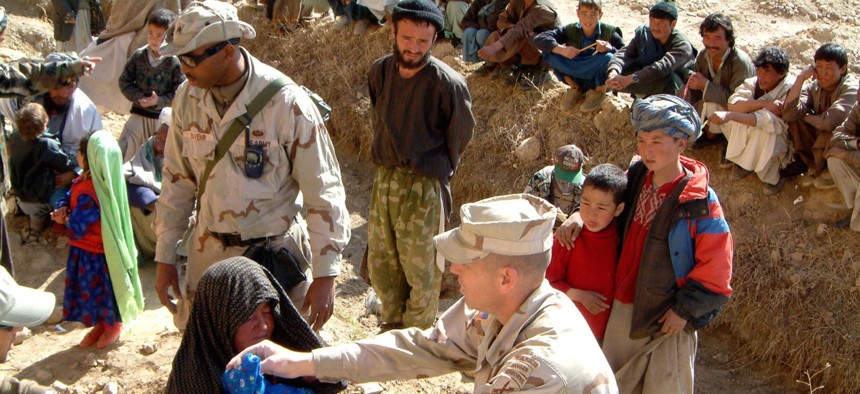
Army file photo
U.S. Soldiers Will Be Armed With Machine Translators to Kill Communication Woes
Communication is critical in most professions, but in some, clear verbal exchanges can mean the difference between life and death.
Communication is critical in most professions, but in some, clear verbal exchanges can mean the difference between life and death. Soldiers in the U.S. Army stationed abroad, for example, must convey and understand information in languages other than English, but don’t always have access to interpreters to help them communicate.
To assist with this, the military has for years been working on a Machine Foreign Language Translation System, rolling out pieces of the software since 2011. The Army will “soon reach full deployment” of the platform, which runs on military and commercial devices, like laptops and phones, the translation industry publication Slator reported in December.
The military translation system currently supports two spoken languages—Pashto and Iraqi Arabic—and one written language, Modern Standard Arabic, but additions are being considered. In November, the Army published information requests from potential vendors to develop Dari, a Persian language spoken predominantly in Afghanistan, and Sorani Kurdish speech-to-speech translation language packs as well.
MFLTS “assists soldiers in communicating effectively with foreign, non-English speaking populations by providing an automated foreign speech and text language translation capability,” according to an Army blog post. But the software isn’t designed to replace human interpreters, the military writes. Rather, it is meant to “augment and complement” their work. For example, soldiers can use the software to check the accuracy of a human interpreter’s translations.
That said, the tool is also designed for independent use as, by the military’s own admission, not every soldier will always be accompanied by an interpreter, especially as the number of enlisted soldiers is reduced through 2018.
“Unfortunately, there aren’t enough linguists to go around and not all of them can put on a rucksack and go up and down mountains in Afghanistan and follow troops around, so we have to fill that capability gap with these devices,” Michael Beaulieu, MFLTS’s product director, explained in 2011 in the blog for Intelligence Electronic Warfare & Sensors, an army division that develops sensors (its blog covers military technologies).
The U.S. military has been on the receiving end of some criticism for its development of MFLTS, costing taxpayers millions of dollars, when there are already universal translation apps in existence. But in fairness, an army’s linguistic needs are unique and its software covers specific military issues, like base security, so it’s perhaps not that surprising the government isn’t relying on a publicly available app. According to a 2014 “unclassified document” seen by Slator, the projected total spend on MFLTS research, development, testing and evaluation for 2013 to 2016 was $12.5 million.
Given the limitation on adventurous linguists—the military is hiring now—and its uncommon requirements, MFLTS comes loaded with ready-made phrases soldiers on their own can play to communicate with locals. To understand the reply to their automated questions, soldiers rely on the machine translator.
It all sounds very civilized in theory. But remember, this is the business of war, so in reality the system seems slightly crude and at least a little creepy. The earliest versions of MFLTS spoke very simply, according to IEW&S, uttering phrases like “get out of the car” or “what is your brother’s name?” or “do you have a bomb?” A soldier would touch that phrase on the screen and it would come out in the other language.
The software has since been developed further—although specifics on current capabilities aren’t publicly available—and MFLTS is being promoted as a tool to aid soldiers working with human interpreters and translators. But based on the military’s stated intention to widely distribute the program, it wasn’t created solely as a complementary measure.
The application fills an important linguistic capability gap, according to Beaulieu. He called communication a key cornerstone for military success, explaining, “If you can’t talk to the people who you are trying to win the hearts and minds of, it is kind of hard to win a counterinsurgency.”






